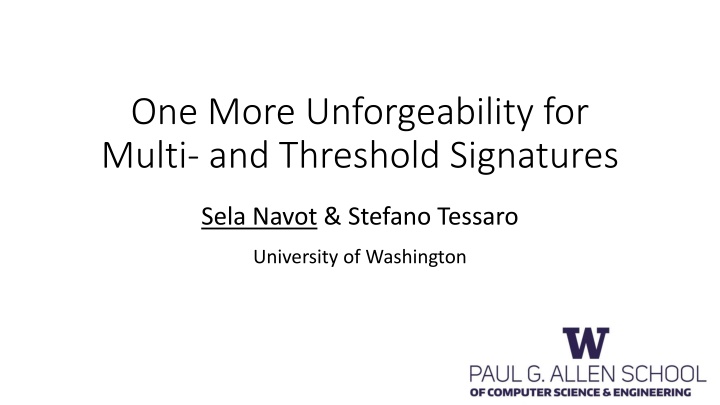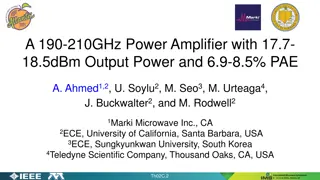
Unforgeability in Multi- and Threshold Signatures Research
Delve into the realm of strong unforgeability for multi- and threshold signatures, exploring challenges, motivations, and the significance of NIST/IETF standardization efforts in the context of EdDSA. Discover the nuances of existential and strong unforgeability in plain signatures, along with case studies and definitions shaping the discourse in this scholarly pursuit.
Download Presentation

Please find below an Image/Link to download the presentation.
The content on the website is provided AS IS for your information and personal use only. It may not be sold, licensed, or shared on other websites without obtaining consent from the author. If you encounter any issues during the download, it is possible that the publisher has removed the file from their server.
You are allowed to download the files provided on this website for personal or commercial use, subject to the condition that they are used lawfully. All files are the property of their respective owners.
The content on the website is provided AS IS for your information and personal use only. It may not be sold, licensed, or shared on other websites without obtaining consent from the author.
E N D
Presentation Transcript
One More Unforgeability for Multi- and Threshold Signatures Sela Navot & Stefano Tessaro University of Washington
Introduction Often strongly unforgeable Multi- and Threshold Signatures: protocols to generate digital signatures distributively. Example: MuSig, MuSig2, FROST, and ROAST generate Schnorr signatures. Strongly unforgeable Does strong unforgeability carry over to the MS / TS schemes? Not always. Because of interactive signing. Corrupted signers.
Motivation NIST / IETF standardization efforts. [ ] with EdDSA being SUF in the conventional setting, it is useful that a threshold scheme interchangeable w.r.t. EdDSA considers a threshold notion of SUF within the claimed corruption threshold. [NIST, 2022] Paraphrased: TS schemes that generate SUF signatures should be SUF. Usage in Bitcoin and blockchain ecosystems. History of attacks abusing non-SUF signature schemes. Can multi-signatures introduce such vulnerabilities?
Our work: What is strong unforgeability for multi- and threshold signatures?
Talk Outline 1. Review: existential and strong unforgeability 2. Multi-Signatures Case studies Defining strong unforgeability Results 3. Threshold Signatures
Existential Unforgeability of Plain Signatures ?? Adversary ? is given a target ??. ? queries a signing oracle for adaptively chosen messages. ? outputs a signature ? for a message ?. 1. 2. ?1 ?1 3. ?? ?? (?,?) ? wins if ? is valid for ? under ??, and ? {?1, ,??}. Definition: EUF-CMA Security No efficient adversary wins with non-neg. probability.
Strong Unforgeability of Plain Signatures ?? Adversary ? is given a target ??. ? queries a signing oracle for adaptively chosen messages. ? outputs a signature ? for a message ?. 1. 2. ?1 ?1 3. ?? ?? (?,?) ? wins if ? is valid for ? under ??, and ? {?1, ,??}. (?,?) {(?1,?1), ,(??,??)}.
Now: Multi-Signatures Setting:? signers, each with their own secret and public key. A multi-signature attests that each signer agreed to sign this message with this group of signers.
Multi-Signatures Signers generate their own keys Signing typically involves an interactive, multi-round protocol. Verified w.r.t a (short) aggregate verification key. Threat model: adversary with corrupt signers, controls communication ?? A??( , , )
Case Study: HBMS Multi-Signatures (Bellare & Dai, 2021) Signing: an interactive 2-round protocol HBMS multi-signatures: A tuple (?,?,?)satisfying ??2= ???2 ??? ?, ?? ?= ? ??, ?, where = ?(?,??1, ,???). These are strongly unforgeable plain signatures! ??3= ???3 ??1= ???1 ? ?(?, ??1, , ???) ?? ??? Existentially unforgeable as a MS scheme (DL assumption in the ROM) ?=1
HBMS: Continued (Using the ROS attack of Benhamouda et al., 2021; see our paper for attack details) An adversary with 1 colluding signer can: 1. Start log( ? ) concurrent signing sessions for a message ?. 2. Obtain legitimate multi-signatures for ?. 3. Forge another multi-signature for ?. Breaks the notion of strong unforgeability.
HBMS: Summary Produces strongly unforgeable plain signatures. Existentially unforgeable multi-signature scheme. Not a strongly unforgeable multi-signature scheme.
In Contrast: MuSig & MuSig2 (Maxwell et al. 2019) & (Nick et al., 2021) Resist the attack against HBMS. Appear to satisfy a notion of strong unforgeability. To prove that, we need to define SUF for multi-signatures.
Unforgeability of Multi-Signatures Threat Model: ? controls all but one signer. Game Definition: ?is given an honest signer s ??, signing oracle access. ?? 1, ,???1 1) Sign ?1 with (??1 Signature share ?, ,???? ?) Sign ?? with (??1 Signature share Note: sessions can happen concurrently! (?,?,(??1, ,???)) Adversary s Goal: Forge a multi-signature.
Unforgeability of Multi-Signatures ?? (?,?,(??1, ,???)) To win: ?? ??1, ,??? & ? is non-trivial. Non-trivial Definition: For EUF: Signing oracle didn t sign ?with this group of signers. Idea for SUF: The signing oracle did not produce ?. But the signing oracle outputs signature shares, not multi-signatures! No well-defined mapping of signature shares to multi-signatures.
Strong Unforgeability for plain signatures: Alternative Notion Previously: ?can t obtain a valid signature that is not a signing oracle response. Alternatively: One-More Unforgeability ?can t obtain + 1 signatures for ? after signing queries for ?. ?? ?1 ?1 ?? ?? , ,? +1 (?,?1 ) With some caveats, the notions are equivalent for plain signatures. (For equivalence: ?can t obtain + 1 signatures for ? after distinct signing oracle responses on queries for ?.)
SUF for Multi-Signatures via One more unforgeability ?? Idea: after signing sessions for ?, ? can obtain multi-signatures for ?. Game: ? outputs: + 1 signatures message ? a group of signers containing ?? Winning Condition: All signatures are valid and distinct. Signing oracle completed sessions for ? with this group of signers. (?,(?1, ,? +1),(??1, ,???))
Multi-Signatures: Results Scheme OMUF? Notes HBMS(Bellare & Dai, 2021) No Not OMUF in the model where it was proved existentially unforgeable. mBCJ(Drijvers et al., 2021) No Not EUF in our model. MuSig(Maxwell et al. 2019) Yes MuSig2(Nick et al., 2021) Yes HBMS and mBCJ: OMUF is broken in poly-time using an ROS attack (Benhamouda et al. 2021). MuSig and MuSig2: OMUF proof is nearly identical to existential unforgeability proof.
Now: Threshold-Signatures Setting: A secret key is secret-shared among ? signers (using Distributed Key Generation protocol or a trusted dealer) ??1 ??2 ??3 Signing Protocol ? Signature Any subset ? or more signers can produce a signature via an interactive protocol. Note: The verification key is independent on the signing subset.
Unforgeability of Threshold Signatures Many existential unforgeability definitions, some complexities. More than one honest signers Static vs. adaptive security DKG vs. idealized key generation Strong Unforgeability? Bellare et al. (2022) define SUF for a limited class of FROST-like schemes. Can we define strong unforgeability in a more generic way? One-More Unforgeability!
Threshold Signatures: Results When restricted to schemes where the existing SUF definition applies: Implies SUF of Bellare et al. (Crypto 2022) Our main OMUF definition Not implies Consequently, FROST (Komlo & Goldberg, 2020) satisfies one-more unforgeability. ROAST (Ruffing et al., 2022) does not satisfy one-more unforgeability.
Summary MS / TS schemes that generate strongly unforgeable plain signatures are not always strongly unforgeable. One-More Unforgeability is a useful way to model strong unforgeability. Thank You! Full paper: https://eprint.iacr.org/2024/1947


